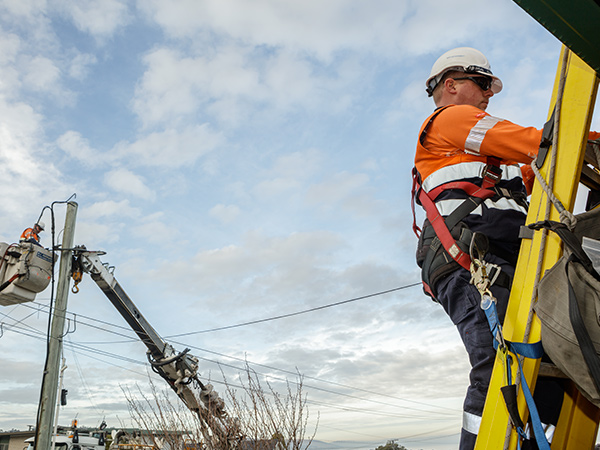Electricity easements
An electricity easement is a legal right over land for the development, maintenance and operation of our infrastructure. There are 3 types of easements.
Registered
A set of legal rights and restrictions over land favouring a person or party registered on the property title
Unregistered
Created by agreement with landowners at the time they were acquired and aren't registered on the property title
Deemed
Where we have infrastructure on a property established before 6 November 1996. Also known as statutory easements
Overhead clearances
If no easement is in place, or you wish to undertake work within the prescribed or standard easement width areas, you'll need to undertake investigations to determine the relevant clearance distances applicable. These clearance distances vary depending on a range of factors including span lengths, conductor tension, mounting heights and the characteristics of the structures proposed in close proximity.
Your building designer will need to provide detailed information of the works proposed, the location and characteristics of the nearby infrastructure and demonstrate compliance with the relevant Australian Standards (AS/NZS7000 and AS/NZS3000).
Underground clearances
Along with Dial Before You Dig, we can provide information on the approximate locations of underground electricity infrastructure. The location of service connections within individual properties is typically not provided.
We recommend Dial Before You Dig enquiries always be made before any earthworks as this will aid awareness about all underground infrastructure potentially affecting land.
If you aren't aware of the location of private underground assets or want to work close to known assets, contact an accredited underground services locator before undertaking earthworks.
If easements aren't in place, we recommend buildings and structures maintain a minimum horizontal clearance of:
- 2 metres from either side of underground cables ≤44kV
- 5 metres for either side of underground cables ≥110kV
Frequently asked questions
-
What's an electricity easement?
An electricity easement is a legal right over land for the development, maintenance and operation of electricity infrastructure.
The width of easements can vary and in some cases may extend onto adjacent land. While ownership of the land remains with the property owner, we're the owner of the easement. This gives us the right to construct, operate and maintain infrastructure on the site, access it whenever required and implement necessary safety controls and actions (including vegetation clearance). Property owners can continue to use the land as they wish, provided there's no interference with our operation of the assets or potential safety risk.
Restrictions apply to activities like erecting structures and buildings, storing materials, undertaking excavation work and lighting of fires within the easement.
-
What if there's no easement on my property?
Even when there are no registered or statutory easements or other formal wayleave agreements, setback requirements continue to apply. In these instances, the safety clearance setbacks applicable are directed by regulatory and industry standards. For overhead powerlines, these include AS/NZS7000:2016 (Overhead line design) to the first point of attachment within private land, and AS/NZS3000:2016 (Electrical installations) from the first point of attachment onward.
In all instances, the provisions of the Electricity Supply Industry Act 1995 apply and require there be no interference with electrical infrastructure without proper authority.
-
Why are easements necessary?
Easements secure the rights and controls necessary for us to ensure the safety and wellbeing of people and property when near powerlines.
Easements also provide us with a right of clear access to the property on a permanent 24-hour basis to ensure powerlines can be regularly or immediately inspected, maintained or repaired. In doing so, it enables us to maintain a safe and reliable supply of electricity.
-
What electrical infrastructure and easement types are over land?
Easement types and controls can vary depending on the infrastructure in place. View the types of easements.
Contact us on 1300 137 008 or send us an enquiry if you'd like to know more about the electrical infrastructure located on your land, or are considering buying land and want to know the types of easement or safety setback standards applicable.
To determine whether a registered easement is present, you'll need to view a copy of the title to that land. The title will detail the location of the easement, our rights and restrictions on the landowner. If you don't have access to a copy of the title, you can do a title search at theLIST.
We provide a search service to locate unregistered easements (transmission network only). A fee is charged for this service. To carry out a search for transmission easements, complete a Wayleave Search Form (PDF) and return to us along with your cheque to:
Wayleaves Officer
TasNetworks
PO Box 606
MOONAH TAS 7009
-
What can and can't I do in an easement?
Before undertaking any works or activities within an easement, ensure you understand what type of easement affects your land and any specific requirements and restrictions that have been assigned to it. Your building designer or a legal adviser may be able to assist you.
Find more information on controlled and restricted activities within transmission easements in our brochure (PDF) and within distribution easements in our Building Near Powerlines brochure (PDF). Also check whether the works or activity you propose require approval permits from your local council.
-
What are my responsibilities if there's an easement on my property?
We require unhindered access to our electrical infrastructure at all times. This includes approved agents and contractors.
As a landowner, you're responsible for ensuring all structures on your property are built outside easements and clearance zones. When planning works or activities on your land, ensure your architects, builders and landscapers are aware of the location of electricity infrastructure on your land and the relevant requirements such as minimum safe clearance distances and accessibility needs.
Our requirements are in addition to any your local council may have for the activity or development you propose and it's important to ensure all requirements have been met. Failure to do so may result in the removal or relocation of your structure, or the relocation of the electricity assets at your expense.
While we can provide some assistance in helping you identify if your property's affected by an easement and the easement type, it's your responsibility to investigate and establish the extent of restrictions relevant to specific easements (as they can vary even among easement types). This may require you to obtain assistance from your building designer or legal adviser.
Responsibility for vegetation management within easements can vary. Typically, property owners have a legal responsibility to ensure foliage and vegetation on their land is a safe distance from the powerlines servicing their properties.
-
What are our responsibilities when it comes to easements?
We're responsible for the safe and reliable supply of electricity. This includes ensuring minimum safety clearances from our infrastructure are maintained.
As a result, we (and our contractors) may need to access your property when we need to:
- Inspect, maintain, demolish, alter or add to our infrastructure
- Manage vegetation
- Remove structures that could interfere with our lines
Unless it's an emergency situation, we'll attempt to notify you before performing any clearing works on your property and after completing those works will leave your property in the condition we found it (excluding any works we are required to carry out to ensure a safe and reliable supply).
We’ll do our best to work with you to determine routes for access to easements and on the timing of any maintenance work. We’ll consult at an early stage and ensure your comments can be considered in the design of a development project and we’ll leave your fences and gates as we find them.

Working near powerlines
There are rules that detail how close you can work to powerlines


